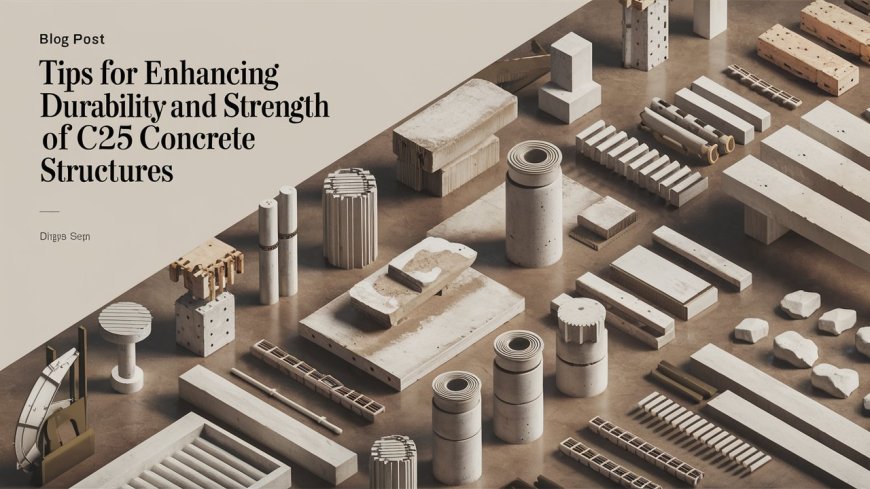Tips for Enhancing Durability and Strength of C25 Concrete Structures
Learn practical tips to enhance the strength and durability of C25 concrete structures. Improve longevity with expert advice.

Concrete, one of the most versatile and widely used construction materials, owes its popularity to its durability and strength. C25 concrete, a commonly used mix with a compressive strength of 25 MPa, is suitable for various construction applications, from residential foundations to commercial buildings. However, certain practices and techniques should be followed to ensure the long-term performance and resilience of C25 concrete structures. Proper implementation of these practices can significantly:
-
Increase the material's lifespan.
-
Reduce maintenance costs
-
Improve overall structural integrity
Tips to Enhance the Durability of C25 Concrete Structures
-
Proper Mix Design
The foundation of durable and strong concrete lies in its mixed design. A well-designed mix should have the right proportions of:
-
Cement
-
Aggregates
-
Water
For C25 concrete mix ratio, adequate cement content is crucial, as too little cement can minimise the concrete's strength while too much can raise the risk of shrinkage and cracking. A lower water-cement ratio (typically around 0.45 to 0.55 for C25) is ideal for strength, but it is essential to ensure that the mix remains workable. Using clean, well-graded aggregates can also develop the concrete’s structural integrity.
Read More Articles: The Technical Innovations of Sanson d'Abbeville in Cartography
-
Use of Admixtures
Plasticizers and superplasticizers improve workability without increasing water content. Air-entraining agents create microscopic air bubbles to boost freeze-thaw resistance. Additionally, using silica fume and fly ash can augment strength and durability by:
-
Reducing porosity
-
Enhancing the chemical resistance of the concrete
-
Quality Control During Mixing
Consistent quality control during the mixing process determines that the concrete achieves the desired properties. Accurate measurement and batching of materials are necessary to maintain the specified mix proportions. Sufficient mixing time is also vital to achieve a homogeneous mix, as under-mixing can lead to weak spots, while over-mixing can cause segregation.
-
Proper Placement and Compaction
How the C25 concrete mix is placed and compacted significantly affects its strength. To prevent segregation, you must:
-
Avoid placing concrete from excessive heights
-
Use chutes, pumps, or buggies to place concrete as close to its final position as possible
Plus, using mechanical vibrators for compaction eliminates air pockets and voids while making denser and stronger concrete.
-
Curing Techniques
Curing is a critical step that affects the long-term performance of concrete. Keeping the concrete moist for at least seven days guarantees proper hydration. This can be achieved through:
-
Wet burlap
-
Water sprays
-
Curing blankets
In hot or dry conditions, applying curing compounds can help retain moisture in the concrete. It is also essential to protect the concrete from rapid drying, which can lead to cracking and reduced strength, especially in windy or hot weather.
-
Protecting Concrete During Construction
Concrete structures are vulnerable to damage during construction. To maximise durability, try not to subject freshly placed concrete to excessive loads until it has gained sufficient strength. Shielding the concrete from extreme weather conditions using tarps or protective sheeting is essential. Moreover, reducing vibrations and shocks around freshly placed concrete helps prevent micro-cracks.
-
Design Considerations for Durability
Ensuring adequate cover to reinforcement protects against corrosion. For C25 concrete, a cover of at least 25 mm is generally recommended. Properly designing and placing construction and expansion joints can accommodate movements and reduce cracking. Implementing effective drainage systems prevents water accumulation and ingress, which can lead to deterioration.
-
Regular Maintenance
Even the most durable concrete structures require regular maintenance. You should conduct periodic inspections to identify and address:
-
Cracks
-
Spalling
-
Other signs of distress
Promptly repair any damages using suitable materials and techniques; small cracks can be sealed with epoxy or polyurethane injections. Applying protective coatings or sealants can prevent water and chemical ingress, which further contributes to uplifting the structure's durability.
-
Environmental Considerations
Concrete structures are exposed to various environmental factors that can affect their resilience. In cold climates, making sure that the concrete mix includes air entrainment helps resist freeze-thaw cycles. In areas with high chemical exposure, using sulfate-resistant cement and protective coatings is beneficial. To prevent alkali-silica reaction (ASR), use low-alkali cement and non-reactive aggregates, as ASR can cause cracking.
Read More Articles: Sanson d'Abbeville and the Political Landscape of 17th Century Europe
-
Sustainable Practices
Incorporating sustainable practices can elevate the durability and reduce the environmental impact of concrete structures. Using recycled aggregates and supplementary cementitious materials like fly ash and slag contributes to sustainability. In addition, implementing energy-efficient curing methods, such as using solar power for curing heat, can also be helpful. Designing structures for long life and adaptability reduces the need for frequent repairs and replacements, thus promoting sustainability.
-
Advancements in Technology
The integration of self-healing concrete, which uses bacteria or chemical agents to seal cracks automatically:
-
Decreases the need for frequent repairs
-
Extends the lifespan of structures
Additionally, the use of fiber-reinforced concrete, incorporating steel, glass, or synthetic fibers, drastically strengthens tensile strength and resistance to cracking. Utilising these innovative materials and techniques can optimise the performance and longevity of C25 concrete, which ultimately determines that structures are not only durable but also resilient against the evolving challenges of modern construction.
Takeaway
Boosting the durability and strength of C25 concrete structures involves a combination of techniques that must be executed by professionals with experience and expertise since it requires knowledge to make a precise C25 concrete mix ratio that is tailored according to your specific needs. By following these tips, you can ensure that your concrete structures meet and exceed their performance expectations while providing lasting value and resilience.
Whether you’re constructing a new building or maintaining an existing one, our specialists at Pro-Mix Concrete will assist you in building concrete structures that stand the test of time!
What's Your Reaction?



























